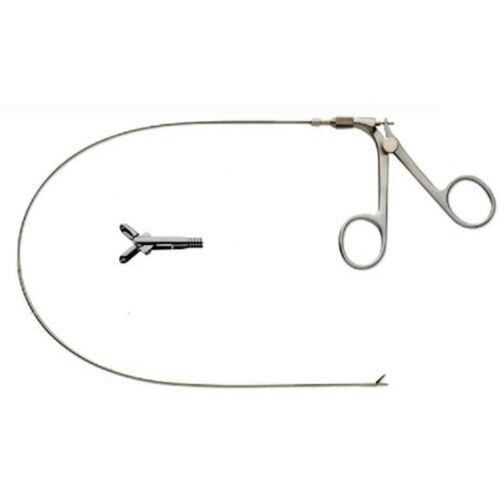
Cystoscopy Flexible Grasping Forceps
Enhancing Precision and Efficiency: The Cystoscopy Flexible Grasping Forceps
Introduction: Cystoscopy, a crucial diagnostic and therapeutic procedure in urology, demands precision and dexterity. Within this realm, the cystoscopy flexible grasping forceps stands as a fundamental tool, facilitating the intricate manipulation of tissues and objects within the urinary tract. This article delves into the design, functionality, and significance of this indispensable surgical instrument.
Design and Functionality: The cystoscopy flexible grasping forceps is meticulously engineered to navigate the complex anatomy of the urinary tract. Composed of high-grade materials such as stainless steel and advanced polymers, this instrument boasts flexibility, durability, and biocompatibility. Its slender, elongated shaft allows for easy insertion through cystoscopes, reaching deep into the urinary system with minimal trauma.
At the distal end, the forceps feature precision jaws equipped with a grasping mechanism. These jaws come in various configurations, including straight, angled, and fenestrated designs, catering to diverse procedural requirements. The grasping mechanism, operated via a control mechanism at the proximal end, enables clinicians to delicately grasp and manipulate tissues, calculi, or foreign bodies with exceptional control and precision.
Significance in Clinical Practice: The cystoscopy flexible grasping forceps plays a pivotal role in a myriad of diagnostic and therapeutic interventions within urology. In diagnostic cystoscopy, it facilitates the retrieval of tissue samples for biopsy, aiding in the accurate diagnosis of malignancies, inflammatory conditions, and infectious diseases of the urinary tract. Moreover, during therapeutic procedures such as stone retrieval, the forceps enable the precise grasping and extraction of urinary calculi, mitigating the risk of urethral injury and ensuring complete stone clearance.
One of the notable applications of this instrument is in the management of ureteral stent complications. In cases of stent migration, encrustation, or fragmentation, the forceps allow for the safe and efficient retrieval or repositioning of stents under direct visualization, minimizing patient discomfort and procedural complications.
Furthermore, the cystoscopy flexible grasping forceps finds utility in minimally invasive endourological procedures such as transurethral resection of bladder tumors (TURBT) and laser lithotripsy. Its precise grasping and manipulation capabilities facilitate the meticulous resection of bladder lesions and the extraction of fragmented calculi, ensuring optimal therapeutic outcomes while preserving healthy surrounding tissue.
Innovations and Future Directions: Advancements in surgical technology continue to refine the design and functionality of cystoscopy flexible grasping forceps. Incorporation of features such as enhanced jaw articulation, ergonomic handle designs, and integration with imaging modalities like fluoroscopy and endoscopic ultrasound hold promise for further improving procedural efficiency and patient outcomes.
Moreover, ongoing research endeavors focus on the development of novel materials with advanced properties such as shape memory alloys and nanocomposites, aiming to enhance the durability, flexibility, and biocompatibility of these instruments.
Conclusion: The cystoscopy flexible grasping forceps stands as an indispensable tool in the armamentarium of urological surgeons, empowering them with precision, versatility, and control in the management of a wide spectrum of urinary tract pathologies. As technology continues to evolve and innovation drives forward, this essential instrument will continue to play a pivotal role in advancing the standards of care in urological practice, ultimately benefiting patients worldwide.